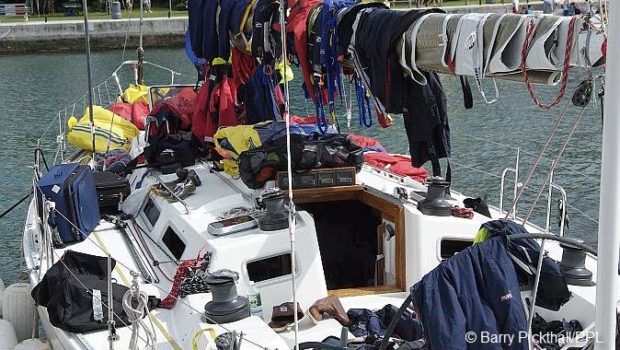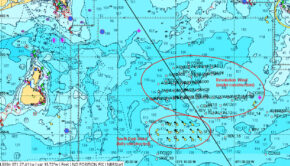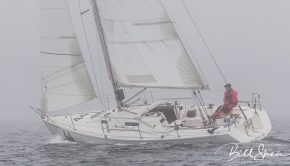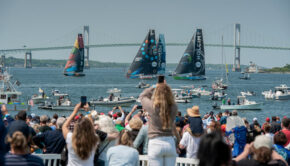Packing Smart is the Best Plan
Published on June 6th, 2016
When the 2016 Newport Bermuda Race gets underway on June 17, Chris Museler plans to start the race dry and rested and comfortable, and to stay that way for 635 miles to St. David’s Head. Here Chris shares his packing secrets…
I grabbed several bulky duffels as I hopped from the launch onto the Andrews 68 Simon Says Oakcliff, my ride in the Block Island Race over Memorial day weekend. “Umph!” was the sound my crewmate made as she hefted a bag over the lifelines as we readied for our only training as a team before the Newport Bermuda Race.
Of the 17 crew for that 24-hour race in and out of Long Island Sound, more than half had bulging bags, nearing 40 pounds with straining zippers. After the first night of windy reaching, a crash jibe in a rainy squall and some beating, several of my shipmates sat in the cool morning air with damp layers and cold, wet feet – all wishing they had a blanket.
Maybe someone actually said that for ocean racing, “If you don’t know what to pack, pack a lot.” But I have learned that packing smart is a better plan.
For the Bermuda Race, we are sailing from chilly 50-degree water and spring in New England, over four days, to 80-degree water and summer in Bermuda. Not only does this dramatic crossover warrant different personal sailing gear, but the nature of ocean racing forces sailors to keep their bags light and also small enough to fit aboard and not degrade performance.
These two notions are at odds, but there are a few philosophies, and some great technical clothing, that allow for a near-perfect compromise in your Bermuda Race attire.
Your foul weather top and bottoms and boots are your most important pieces of sailing gear next to your safety harness. Remember, if you are bothered or compromised by your comfort, you aren’t able to do as good a job on deck and will tire quickly.
That’s why I do not use boat shoes during the race. They get wet, and I don’t mind plodding around in boots and will throw on bibs at the sign of water coming on deck.
One Modest Seabag with Good Gear
Most racing teams send “shore clothes” on ahead to the Royal Bermuda Yacht Club. Assuming this, I carry aboard just one bag that includes the following:
• Coastal Musto MPX full-zip jacket
• Coastal Musto MPX Dry Top with latex wrist and neck seals
• Offshore Musto HPX Trousers with thin knee pads inserted (for working on deck)
• Le Chameau Neoprene sea boots with gators (used on high speed boats or in cold weather), or
• Dubarry Ultimate Gore Tex leather sea boots (for a lighter wind or hot-weather race).
Many companies produce great foul weather gear. Musto, Henri Lloyd, Helly Hansen, Gill, and Zhik make durable, technical gear. But all foulies eventually get “wetted out” where the outer layer begins to fail and conditions pound on the waterproof membrane beneath.
You can extend the life of your gear by using a cleaner like NikWax Tech Wash and then a re-waterproofing like Revivex Wash-In Waterproofing. I learned these tips from Martha Parker at Team One Newport, and I used these products in the last Bermuda Race with great success.
The rest of my personal gear includes:
• one baseball cap and one thin, breathable Helly Hansen Lifa cap
• one short-sleeved and one long-sleeved mid-weight breathable shirt (Gil and Patagonia)
• mid-weight thermal bottoms (EMS)
• a fleece vest (Patagonia)
• three pairs of socks (two silk-weight and one mid-weight by EMS)
• and – VERY important — a personal alarm not only to wake me 15 minutes before going on watch, but also to alert me to prepare warm drinks or snacks for my watchmates.
I do not wear sailing gloves though they’re great if you haven’t handled lines in a while.
When I pack my seabag, I separate all the personal gear into three large Ziplocs labeled Tops, Bottoms, and Socks. This packing list seems austere but it adds up. It’s very important to plan ahead to protect the dryness of your gear.
Ultimately, no matter how much clothing you have, if you don’t work on keeping it dry all the time, chances are you will be stuck wet and cold for long periods of time. Asking permission from your watch captain to go below to change out of your wet clothes during a late night watch is disturbing to your shipmates both on and below deck.
My offshore clothing philosophy revolves 100% around staying as dry as possible, letting the technical gear do its work and airing gear out discretely when weather permits. I always suit up early. Sailors in their cotton shorts and polo shirts will be comfortable when jogging around before the start, but once the gun fires and the spray starts flying, they’ll be jumping below to change out of their soaking wet clothes, just when they’re needed on deck.
Sleep and Socks
If it’s not too hot below, I prefer to sleep in my gear with my harness on. If your boat has a ‘hot bunk’ system, some concessions must be made. Shared bedding must be kept religiously dry. I have found that even with an occasional dousing down the neck or some water in my boots, and with good Gore Tex gear and breathable thermals, I am dry by the time I wake up from an off watch.
Once we’re in or south of the Gulf Stream, it can get quite warm below (as we saw in the light-wind 2014 race). That’s when my bare minimum sleeping attire consists of a quick-dry Tee, surf shorts, and socks so I can step back into my boots as I come off the bunk.
I always wear socks on board. Getting a foot fungus from some less hygienic shipmates early in my offshore career made a strong impression on me. On sunny dry days, I will tie moist socks to the aft lifeline for part of a watch to get them nice and dry. I also try to air out my boots and feet during those times. If it’s a blustery race, I stay buttoned up, both above and below decks.
I wear boots and bibs unless there is only a minor threat of water or spray coming over the deck. Unzipped bibs, mid- to lightweight long underwear bottoms, and a breathable T-shirt are surprisingly cool and keep the sun off.
In the Block Island Race, I observed my usual practice of donning my long underwear, bibs, and boots well before the beginning of the evening watches, when many of my crewmates were still in sneakers and shorts. This routine avoids the dash below when a twilight squall hits, or the temperature drops quickly as the sun sets. I am also prepared to be on station for any sail changes that come as the ocean-air interface begins to cook up surprises.
Besides clothes, you need personal gear that that can save your life. These include a sharp folding knife, a personal waterproof flashlight, a waterproof headlamp, and a Personal Locator Beacon. I write my first name, CHRIS, on all my gear so new crewmembers are clear where it belongs. If there are two Chris’s, I put an “M” afterwards. People rarely remember last names or initials.
Many of these tips were learned from professional solo sailors and Volvo Ocean Racers who are only allowed one small bag aboard. They may smell horrid when they arrive after a long ocean race, but they have successfully relied on their quality gear.
I know and understand the many Bermuda Race sailors who swear by a different approach than mine, as they bring along many layers. To live as minimally as I have described takes a lot of self-discipline. Among the rewards (besides a small, light seabag) is the pride you feel about having such efficient clothing.
And it’s really nice to stay dry and comfortable all the way to Bermuda.
Race website – How to follow – Facebook
Background: The 635-mile Newport Bermuda Race, starting on June 17, is the 50th edition and also marks the 90th anniversary of the partnership of the organizers, the Cruising Club of America and Royal Bermuda Yacht Club.









 We’ll keep your information safe.
We’ll keep your information safe.